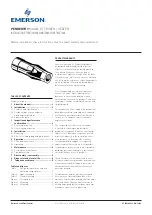
GLOSSARY
PAL
P
hase
A
lternating
L
ines. The dominant color television
format in Western Europe, Australia, most of Asia, and
parts of South America and Africa. PAL is characterized
by each frame being composed of 625 horizontal scan-
ning lines occurring 25 times per second. (Also see
NTSC
and
SECAM
.)
RCTC
R
ewritable
C
onsumer
T
ime
C
ode (also referred to as
RC). Commonly available on 8mm and Hi-8 format
devices.
S-Video
A video standard used by camcorders. S-Video separates
the Y (luminance) and C (chroma) signals to improve sig-
nal quality. Also see
Composite Video
.
SECAM
The standard video signal used in France, Eastern Europe,
and parts of Asia and Africa. Also see
NTSC
and
PAL
.
SMPTE
S
ociety of
M
otion
P
icture and
T
elevision
E
ngineers.
(Pronounced
simp-tee
.) This committee of engineers and
manufacturers establishes the most widely accepted stan-
dard for time code. They created specifications for two
version of time code: LTC and VITC.
Time Code
A method of putting a unique number or address on each
frame of a videotape. There are several formats of time
code. The Society of Motion Picture and Television Engi-
neers set the most common time code standard, called
SMPTE.
VCR
V
ideo
C
assette
R
ecorder. A video device normally used
to record and play back video on cassettes. VCR is a con-
sumer-level term: VCR’s in the professional field are nor-
mally referred to as VTR’s (
V
ideo
T
ape
R
ecorders).
VCR’s and VTR’s perform the same functions, although
VTR’s usually provide many additional features and func-
tions.
Video Editing
The process of applying special effects to video
sequences and assembling those sequences into a video
program.
VITC
V
ertical
I
nterval
T
ime
C
ode. (Pronounced
vit-see
.) An
SMPTE-defined standard for time code, recorded into the
video signal during the vertical blanking interval.
VTR
V
ideo
T
ape
R
ecorder. Similar to VCR (see above) except
that VTR’s are normally used in the professional video
field and contain enhanced features. VCR is normally
used in conjunction with consumer-level electronics.
Summary of Contents for MX-4
Page 1: ...MX 4 User Guide ...
Page 50: ...NOTES ...
Page 70: ...NOTES ...
Page 102: ...NOTES ...
Page 108: ...NOTES ...
Page 136: ...MX 4 USER GUIDE CHAPTER 13 132 ...
Page 138: ...MX 4 USER GUIDE APPENDIX A 134 BASIC TRANSITIONS ...
Page 154: ...NOTES ...
Page 168: ...NOTES ...





































